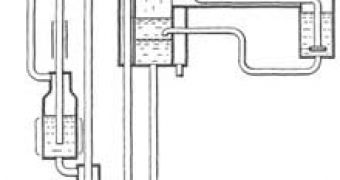The refrigerator model proposed by Einstein was soon replaced with a better one, except now, as global needs change and technology improves, the savant's fridge doesn’t seem such a bad idea anymore, which is why scientists decided to "revive" the genius' electricity-free, environment-friendly icebox.
Modern refrigerators are well-known as sworn enemies to the ozone level, as well as big energy gourmands. They function upon expanding and compressing freons (some man-made greenhouse gases that are way more environmentally-damaging than CO2) and, as developing countries register increasing needs of such items, they are produced in larger quantities.
Malcolm McCulloch is an electrical engineer from Oxford who is keen on "green" technology. He is the head of a 3-year project set to develop domestic appliances for use in places with no electricity. In this regard, he and his team focused on a fridge patent that Albert Einstein and Leo Szilard came up with in the 1930s, which only used pressurized gases and had no moving parts. This was primarily used for refrigerator building until freons proved more efficient and took center stage during the 1950s.
Einstein and Szilard's model used ammonia, butane and water and was based on liquids' property of boiling at lower temperatures in low pressure conditions. As McCulloch explains, "If you go to the top of Mount Everest, water boils at a much lower temperature than it does when you're at sea level and that's because the pressure is much lower up there." A part of the machine was called the evaporator and consisted of a flask containing butane. McCulloch gives further details: "If you introduce a new vapour above the butane, the liquid boiling temperature decreases and, as it boils off, it takes energy from the surroundings to do so. That's what makes it cold."
The scientist plans to make that design more efficient by enhancing it and by using other gas types. Also, he wants to heat a pump, the only energy input required by the fridge, by making use of solar energy. "No moving parts is a real benefit because it can carry on going without maintenance. This could have real applications in rural areas," he adds. His device is not yet finished. "It's very much a prototype; this is nowhere near commercialized," he says. "Give us another month and we'll have it working."
But his is not the only invention in the cold field of environmental refrigerators. Engineers from Cambridge use magnetic fields in order to cool things down. Their managing director, Neil Wilson, states that "Our fridge works, from a conceptual point of view, in a similar way [to gas compressor fridges] but instead of using a gas we use a magnetic field and a special metal alloy. When the magnetic field is next to the alloy, it's like compressing the gas, and when the magnetic field leaves, it's like expanding the gas. This effect can be seen in rubber bands - when you stretch the band it gets hot, and when you let the band contract it gets cold."
Together with air conditioning, instant food cooling and freezing require much "greener" solutions, since they're among the worst ozone-affecting appliances and they’re in high demand in developing countries.

 14 DAY TRIAL //
14 DAY TRIAL //